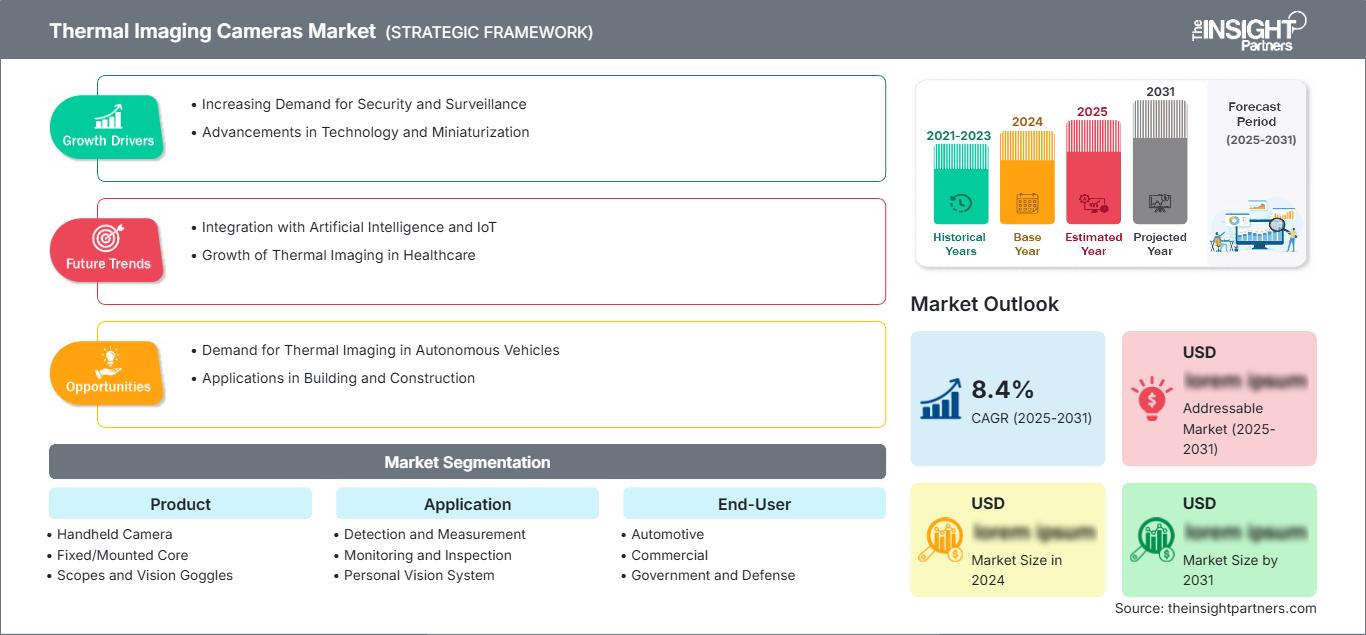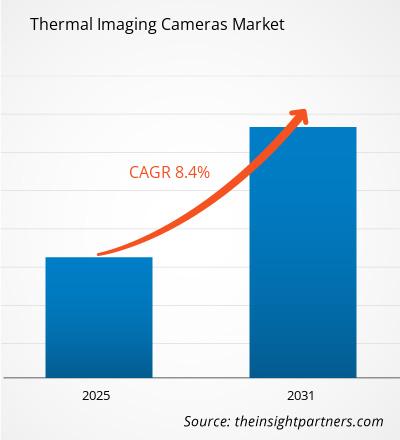Le marché des caméras thermiques devrait enregistrer un TCAC de 8,4 % entre 2025 et 2031, avec une taille de marché passant de XX millions de dollars américains en 2024 à XX millions de dollars américains d'ici 2031.
Le rapport est segmenté par produit (caméra portable, noyau fixe/monté, lunettes de vision) ; application (détection et mesure, surveillance et inspection, système de vision personnel, recherche et sauvetage, sécurité et surveillance, autres) ; utilisateur final (automobile, commerce, gouvernement et défense, santé et sciences de la vie, industrie, résidentiel, autres). L'analyse mondiale est ensuite ventilée au niveau régional et par principaux pays. Le rapport offre la valeur en USD pour l'analyse et les segments ci-dessus.
Objectif du rapport
Le rapport sur le marché des caméras thermiques de The Insight Partners vise à décrire le paysage actuel et la croissance future, les principaux facteurs moteurs, les défis et les opportunités. Cela fournira des informations à diverses parties prenantes commerciales, telles que :
- Fournisseurs/fabricants de technologie : pour comprendre l’évolution de la dynamique du marché et connaître les opportunités de croissance potentielles, leur permettant de prendre des décisions stratégiques éclairées.
- Investisseurs : pour effectuer une analyse complète des tendances concernant le taux de croissance du marché, les projections financières du marché et les opportunités qui existent tout au long de la chaîne de valeur.
- Organismes de réglementation : pour réglementer les politiques et surveiller les activités du marché dans le but de minimiser les abus, de préserver la confiance des investisseurs et de maintenir l’intégrité et la stabilité du marché.
Segmentation du marché des caméras thermiques Produit
- Caméra portable
- Noyau fixe/monté
- Lunettes de vision et lunettes de protection
Application
- Détection et mesure
- Surveillance et inspection
- Système de vision personnel
- Recherche et sauvetage
- Sécurité et surveillance
- Autres
Utilisateur final
- Automobile
- Commercial
- Gouvernement et défense
- Santé et sciences de la vie
- Industriel
- Résidentiel
- Autres
Géographie
- Amérique du Nord
- Europe
- Asie-Pacifique
- Amérique du Sud et centrale
- Moyen-Orient et Afrique
Vous bénéficierez d’une personnalisation sur n’importe quel rapport - gratuitement - y compris des parties de ce rapport, ou une analyse au niveau du pays, un pack de données Excel, ainsi que de profiter d’offres exceptionnelles et de réductions pour les start-ups et les universités
Marché des caméras thermiques: Perspectives stratégiques

- Obtenez les principales tendances clés du marché de ce rapport.Cet échantillon GRATUIT comprendra une analyse de données, allant des tendances du marché aux estimations et prévisions.
Moteurs de croissance du marché des caméras thermiques
- Demande croissante en matière de sécurité et de surveillance : Le besoin croissant de sécurité et de surveillance renforcées dans divers secteurs, notamment la défense, les forces de l'ordre et la sécurité publique, constitue un moteur important pour le marché des caméras thermiques. Ces caméras fournissent des images claires dans des conditions de faible luminosité et de visibilité nulle, ce qui les rend indispensables pour les opérations de surveillance, le contrôle des frontières et les interventions d'urgence. Face à l'augmentation des préoccupations en matière de sécurité à l'échelle mondiale, la demande de caméras thermiques devrait continuer de croître.
- Progrès technologiques et miniaturisation : Les progrès continus de la technologie d'imagerie thermique, notamment le développement de capteurs à plus haute résolution, l'amélioration des algorithmes de traitement d'image et la miniaturisation des composants, stimulent la croissance du marché. Ces innovations rendent les caméras thermiques plus abordables, compactes et accessibles pour un plus large éventail d'applications, de l'électronique grand public aux inspections industrielles, élargissant ainsi leur utilisation dans divers secteurs.
Tendances futures du marché des caméras thermiques
- Intégration à l'intelligence artificielle et à l'IoT : une tendance notable sur le marché des caméras thermiques est l'intégration de l'intelligence artificielle (IA) et de l'Internet des objets (IoT) pour améliorer la fonctionnalité de ces appareils. Les caméras thermiques alimentées par l'IA peuvent analyser les données thermiques en temps réel, identifiant des modèles, des anomalies et des risques potentiels. Cette intégration permet une prise de décision plus intelligente et une automatisation accrue, en particulier dans des applications telles que la sécurité, les soins de santé et la maintenance prédictive.
- Croissance de l'imagerie thermique dans les soins de santé : le secteur de la santé adopte de plus en plus les caméras thermiques à diverses fins de diagnostic et de surveillance, telles que la détection de la fièvre, de l'inflammation et des problèmes de circulation. Cette tendance est également stimulée par la demande croissante de solutions non invasives et sans contact, notamment dans le sillage de la pandémie de COVID-19, où les caméras thermiques sont utilisées pour le dépistage de la fièvre dans les espaces publics et les établissements de santé. L'intégration des caméras thermiques dans les applications de santé devrait se développer à mesure que la technologie devient plus accessible et abordable.
Opportunités de marché des caméras thermiques
- Demande d'imagerie thermique dans les véhicules autonomes : Avec le développement rapide des véhicules autonomes, le marché des caméras thermiques offre des opportunités croissantes dans le secteur automobile. Les caméras thermiques peuvent aider les véhicules autonomes à détecter les piétons, les animaux et les obstacles dans des conditions de faible visibilité, améliorant ainsi la sécurité et la fiabilité de ces véhicules. À mesure que la technologie de conduite autonome progresse, la demande de caméras thermiques devrait augmenter, offrant une opportunité significative d'innovation et d'expansion du marché.
- Applications dans le bâtiment et la construction : Le secteur du bâtiment et de la construction offre des opportunités significatives pour les caméras thermiques, notamment pour les audits énergétiques, la détection d'humidité et les contrôles d'isolation. Les caméras thermiques permettent de détecter les pertes de chaleur, les fuites d'air et les zones potentiellement inefficaces sur le plan énergétique dans les bâtiments, contribuant ainsi aux efforts de réduction de la consommation d'énergie et d'amélioration des performances des bâtiments. La durabilité et l'efficacité énergétique devenant des priorités dans la construction, la demande en solutions d'imagerie thermique devrait augmenter.
Marché des caméras thermiques
Les tendances et facteurs régionaux influençant le marché des caméras thermiques tout au long de la période de prévision ont été analysés en détail par les analystes de The Insight Partners. Cette section aborde également les segments et la répartition géographique du marché des caméras thermiques en Amérique du Nord, en Europe, en Asie-Pacifique, au Moyen-Orient et en Afrique, ainsi qu'en Amérique du Sud et en Amérique centrale.Portée du rapport sur le marché des caméras thermiques| Attribut de rapport | Détails |
|---|---|
| Taille du marché en 2024 | US$ XX million |
| Taille du marché par 2031 | US$ XX Million |
| TCAC mondial (2025 - 2031) | 8.4% |
| Données historiques | 2021-2023 |
| Période de prévision | 2025-2031 |
| Segments couverts |
By Produit
|
| Régions et pays couverts | Amérique du Nord
|
| Leaders du marché et profils d'entreprises clés |
|
Densité des acteurs du marché des caméras thermiques : comprendre son impact sur la dynamique des entreprises
Le marché des caméras thermiques connaît une croissance rapide, portée par une demande croissante des utilisateurs finaux, due à des facteurs tels que l'évolution des préférences des consommateurs, les avancées technologiques et une meilleure connaissance des avantages du produit. Face à cette demande croissante, les entreprises élargissent leur offre, innovent pour répondre aux besoins des consommateurs et capitalisent sur les nouvelles tendances, ce qui alimente la croissance du marché.
- Obtenez le Marché des caméras thermiques Aperçu des principaux acteurs clés
Principaux arguments de vente
- Couverture exhaustive : Le rapport couvre l’analyse exhaustive des produits, services, types et utilisateurs finaux du marché des caméras thermiques, offrant un panorama global.
- Analyse d’experts : Le rapport est élaboré à partir de la connaissance approfondie d’experts et d’analystes du secteur.
- Informations actualisées : Le rapport garantit la pertinence commerciale grâce à sa couverture des informations récentes et des tendances des données.
- Options de personnalisation : Ce rapport peut être personnalisé pour répondre aux besoins spécifiques des clients et s’adapter aux stratégies commerciales.
Le rapport de recherche sur le marché des caméras thermiques peut donc contribuer à la compréhension du marché et des perspectives de croissance. Malgré quelques préoccupations légitimes, les avantages globaux de ce rapport tendent à l’emporter sur les inconvénients.
- Analyse historique (2 ans), année de base, prévision (7 ans) avec TCAC
- Analyse PEST et SWOT
- Taille du marché Valeur / Volume - Mondial, Régional, Pays
- Industrie et paysage concurrentiel
- Ensemble de données Excel
Rapports récents
Témoignages
Raison d'acheter
- Prise de décision éclairée
- Compréhension de la dynamique du marché
- Analyse concurrentielle
- Connaissances clients
- Prévisions de marché
- Atténuation des risques
- Planification stratégique
- Justification des investissements
- Identification des marchés émergents
- Amélioration des stratégies marketing
- Amélioration de l'efficacité opérationnelle
- Alignement sur les tendances réglementaires




















 Obtenez un échantillon gratuit pour - Marché des caméras thermiques
Obtenez un échantillon gratuit pour - Marché des caméras thermiques